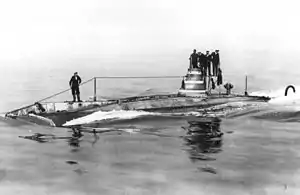 similar HMS A3 | |
| History | |
|---|---|
| Builder | Vickers, Sons & Maxim Ltd. Barrow-in-Furness |
| Laid down | 1 September 1903 |
| Launched | 23 January 1905 |
| Commissioned | 8 May 1905 |
| Fate | Scrapped 1920 |
| Notes | Pennant # I-18 |
| General characteristics | |
| Class and type | A class submarine |
| Displacement | 190 tons surfaced, 207 tons submerged |
| Length | 105.25 ft (32.08 m) |
| Beam | 12.75 ft (3.89 m) |
| Draught | 10.5 ft (3.2 m) |
| Propulsion | 550 hp petrol engine 150 hp electric engine |
| Speed | 11 kn (20 km/h) maximum surfaced 8 kn (15 km/h) maximum submerged |
| Range | 325 nmi (602 km) at 11 kn (20 km/h) surfaced 20 nmi (37 km) at 6 kn (11 km/h) submerged |
| Complement | 11 (2 officers and 9 ratings) |
| Armament | Two 18 inch (457 mm) torpedo tubes, plus two reloads |
HMS A8 was an early Royal Navy submarine.
She was a member of Group Two of the 1903 British A-class of submarines. Like the other members of her class, she was built at Vickers Barrow-in-Furness.
She sank with the loss of 15 crew as a result of an accident whilst running on the surface in Plymouth Sound on 8 June 1905.[1] A sudden dip in the bow caused the submarine to be swamped through the hatch in the conning tower.[1]Only 4 survived. She was salvaged four days after the accident at which point a loose rivet was found in the bow plating.[1] The submarine was then repaired and recommissioned and used for training during the First World War along with A9 as part of the First Submarine Flotilla, operating near Devonport through early 1916. She was scrapped in October 1920 at Dartmouth.
References
- 1 2 3 Gray, Edwyn (2003). Disasters of the Deep A Comprehensive Survey of Submarine Accidents & Disasters. Leo Cooper. pp. 51–52. ISBN 0-85052-987-5.
External links
- MaritimeQuest HMS A-8 Pages
- HMS A-8 Roll of Honour
- 'Submarine Losses 1904 to present day' - Royal Navy Submarine Museum Archived 7 January 2018 at the Wayback Machine